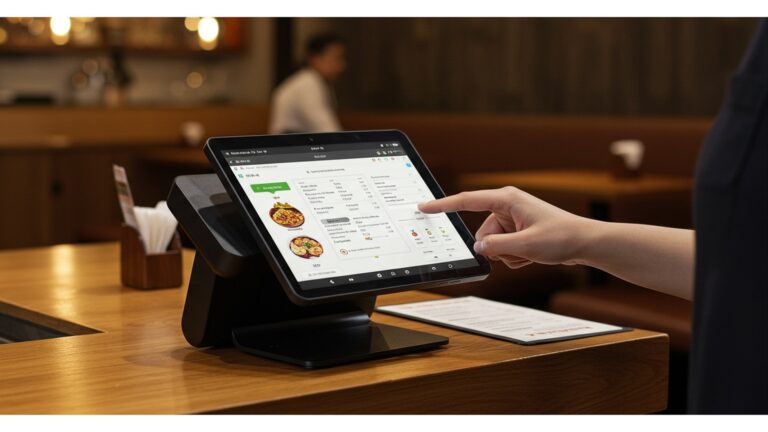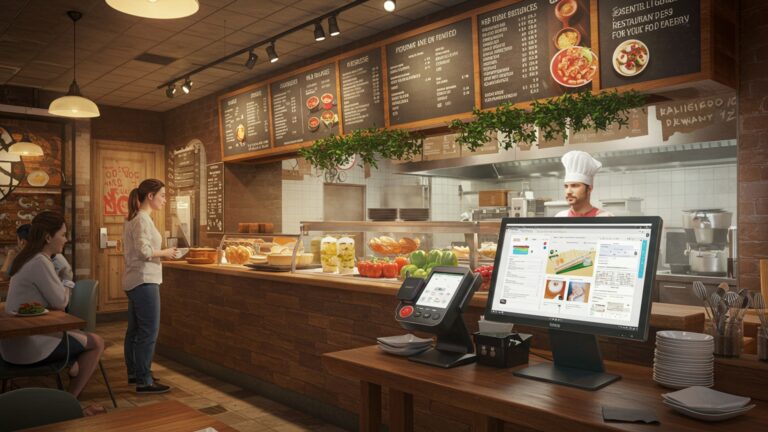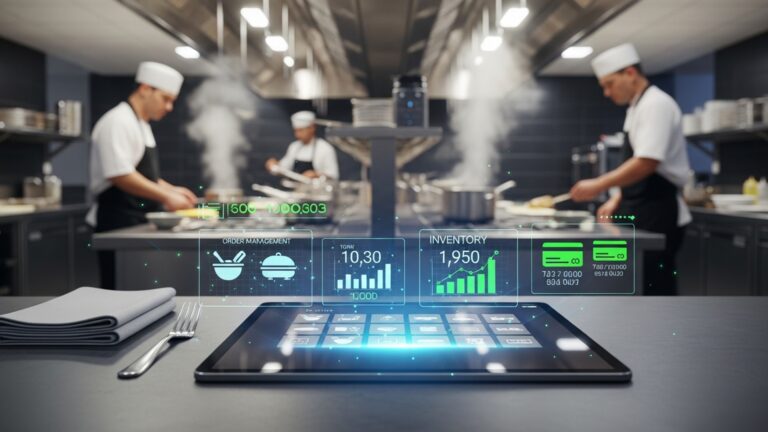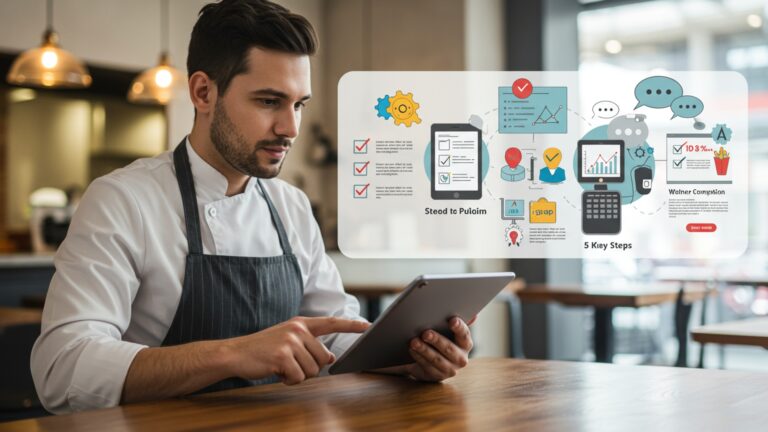7 Smart Ways Restaurant POS Software Boosts Your Business Profitability
Navigating the modern restaurant industry’s tight margins and evolving consumer expectations demands more than just traditional operations; it requires strategic technological leverage. Forward-thinking restaurateurs now recognize that advanced restaurant POS software is not merely a transaction hub but a potent engine for profitability. Recent developments in cloud-based systems, for instance, integrate real-time inventory management with predictive analytics, combating rising food costs and labor shortages. From empowering contactless QR code ordering to providing granular sales data for menu optimization, a robust restaurant POS software transforms operational efficiency and elevates the guest experience, directly boosting your business profitability in tangible ways.
1. Streamlined Order Management and Enhanced Accuracy
At the heart of any successful restaurant operation lies efficient order management. Traditional methods often involve handwritten tickets, which are prone to misinterpretations, lost orders. significant delays. This is where modern Restaurant POS software fundamentally transforms the process. A Point of Sale (POS) system is essentially a digital hub that processes transactions and manages various aspects of your business operations.
When an order is placed, it’s immediately entered into the POS system, either by waitstaff using a tablet or by customers directly through a self-ordering kiosk or online portal. This digital entry ensures that every item, modification. special request is accurately recorded. The order is then instantly transmitted to the relevant kitchen or bar stations via a Kitchen Display System (KDS) or a printer, eliminating handwritten errors and communication breakdowns.
- Reduced Errors: Digital order entry minimizes human error associated with illegible handwriting or misheard instructions. This directly translates to less food waste and fewer comps.
- Faster Service: Orders are sent to the kitchen instantly, cutting down on preparation time and allowing staff to focus on serving customers rather than running back and forth. This leads to quicker table turnover, especially during peak hours.
- Improved Communication: Integrated KDS screens can display order progress, cooking instructions. even allow chefs to mark items as complete, ensuring seamless coordination between front-of-house and back-of-house staff.
Consider a busy Friday night: without a robust Restaurant POS software, a server might mishear a side dish request or forget to punch in a modifier. With a POS, the specific instructions for “steak, medium-rare, no butter, extra asparagus” are precisely communicated, ensuring customer satisfaction and reducing costly re-fires.
2. Optimized Inventory Control and Waste Reduction
Food and beverage costs represent a significant portion of a restaurant’s expenses. Inefficient inventory management can lead to excessive waste, spoilage. even theft, directly eroding profits. Restaurant POS software provides powerful tools to gain granular control over your stock, transforming how you manage your ingredients and supplies.
A comprehensive POS system tracks every ingredient used, from the moment it’s purchased from a vendor to when it’s served to a customer. Every sale automatically deducts ingredients from your inventory counts in real-time. This real-time tracking gives you an accurate picture of what you have on hand, preventing stockouts of popular items and over-ordering of slow-moving ones.
- Automated Tracking: Each dish sold automatically updates ingredient levels, eliminating manual counting and reducing human error in inventory records.
- Vendor Management: Many POS systems allow you to store vendor insights, track purchase orders. even assess vendor performance, helping you negotiate better prices and terms.
- Waste Reduction: By knowing exactly what ingredients are being consumed and at what rate, you can make more precise ordering decisions, significantly reducing spoilage and waste. Alerts can be set for items nearing expiration.
- Theft Prevention: Accurate inventory counts make it harder for internal theft to go unnoticed, as discrepancies between sales and stock levels become immediately apparent.
For example, a restaurant manager using a sophisticated Restaurant POS software can run a report showing that they consistently over-order avocados by 15% each week, leading to spoilage. Adjusting future orders based on this data directly impacts the bottom line, turning potential waste into savings.
3. Enhanced Customer Relationship Management (CRM)
Building a loyal customer base is crucial for long-term profitability. Restaurant POS software goes beyond just processing transactions; it acts as a powerful CRM tool, helping you interpret, engage. retain your customers more effectively.
When customers make a purchase, their details (with consent) can be captured and stored in the POS system. This data can include their order history, dietary preferences, visit frequency. even special occasions. This data empowers restaurants to personalize the dining experience and create targeted marketing campaigns.
- Personalized Experiences: Knowing a customer’s favorite dish or drink allows staff to offer tailored recommendations, making guests feel valued and understood.
- Loyalty Programs: POS systems facilitate the creation and management of loyalty programs, rewarding frequent diners with points, discounts, or exclusive offers. This incentivizes repeat business.
- Targeted Marketing: With customer data, you can segment your audience and send personalized promotions, such as a birthday discount or an offer for their favorite meal.
- Feedback Collection: Some POS systems integrate with feedback tools, allowing you to gather insights from customers and address concerns proactively, improving overall satisfaction.
Imagine a regular customer, Sarah, who always orders the vegan curry. With Restaurant POS software, her preference is noted. When a new vegan special is introduced, the system can automatically send her a personalized email or SMS promotion, enticing her to visit. This level of personalized engagement is far more effective than generic marketing.
4. Data-Driven Decision Making and Reporting
Running a successful restaurant in today’s competitive landscape requires more than just great food; it demands intelligent, data-driven decisions. A key benefit of robust Restaurant POS software is its ability to collect vast amounts of operational data and transform it into actionable insights through comprehensive reporting.
These reports cover virtually every aspect of your business, from sales performance to labor costs and inventory turnover. Managers can access real-time dashboards and generate detailed reports at any time, allowing them to identify trends, pinpoint areas for improvement. make informed strategic choices.
- Sales Performance: examine sales by item, category, time of day, day of week. even by server. This helps identify peak hours, popular dishes. slow-moving items.
- Menu Engineering: By understanding which dishes are most profitable and popular, you can optimize your menu, adjusting pricing, promoting high-margin items, or removing underperforming ones.
- Labor Optimization: Track employee hours, sales per employee. labor costs as a percentage of revenue. This data is invaluable for scheduling staff efficiently to meet demand without overspending.
- Forecasting: Historical sales data allows for more accurate demand forecasting, helping you prepare for busy periods, manage inventory. staff appropriately.
Consider a restaurant owner who sees through their Restaurant POS software reporting that lunch sales on Tuesdays are consistently low, while Saturday brunch is booming. This insight might lead them to offer a “Two-for-One Tuesday” special or reallocate staff from Tuesday lunch to Saturday brunch, directly impacting profitability.
5. Efficient Staff Management and Productivity
Your staff are the backbone of your restaurant. their efficiency directly impacts customer satisfaction and your bottom line. Restaurant POS software plays a pivotal role in streamlining staff-related operations, boosting productivity. reducing labor costs.
Many POS systems come equipped with integrated features for employee management, making tasks like time tracking, shift scheduling. performance monitoring significantly easier. This not only saves managerial time but also ensures fairness and accuracy in payroll.
- Time Clock Integration: Employees can clock in and out directly through the POS, eliminating manual time cards and reducing errors in payroll processing. This feature often comes with biometric options for added accuracy.
- Shift Scheduling: Some advanced POS systems offer tools for creating and managing staff schedules, allowing managers to optimize coverage based on sales forecasts and employee availability.
- Performance Tracking: Monitor individual server performance, including average check size, sales per hour. tips. This data can be used for training, incentives. identifying top performers.
- Reduced Training Time: Modern POS interfaces are often intuitive and user-friendly, meaning new staff can be trained quickly, reducing onboarding costs and getting them productive faster.
For instance, a restaurant utilizing Restaurant POS software can identify that Server A consistently has a higher average check size than Server B. This insight can then be used to provide targeted training for Server B on upselling techniques, ultimately increasing overall revenue without adding more staff.
6. Reduced Operational Costs and Waste
While many of the points above indirectly lead to cost savings, it’s crucial to consolidate how Restaurant POS software directly attacks various operational expenditures, turning potential losses into profit.
Beyond the obvious savings from reduced food waste and optimized labor, POS systems contribute to efficiency across the board, minimizing costs associated with errors, administrative tasks. even payment processing. The move from manual, paper-based systems to integrated digital solutions inherently cuts down on resource consumption and human error.
| Area of Cost Reduction | Traditional Method Challenges | How Restaurant POS Software Helps |
|---|---|---|
| Food Waste | Over-ordering, spoilage from inaccurate inventory, kitchen errors, forgotten orders. | Real-time inventory tracking, automated deduction, precise order transmission, less re-fires. |
| Labor Costs | Manual time cards, inefficient scheduling, overstaffing during slow periods, excessive administrative time. | Integrated time clocks, sales-driven scheduling, performance metrics, reduced manual payroll tasks. |
| Administrative Overhead | Manual data entry, paper-based reporting, reconciliation of multiple systems. | Automated reporting, digital record-keeping, integration with accounting software, streamlined workflows. |
| Payment Processing Fees | Lack of insights into transaction types, potentially higher rates from non-integrated systems. | Consolidated payment processing, potential for better negotiated rates, clear transaction reporting. |
By digitizing and automating these core functions, a restaurant not only becomes more efficient but also gains a clear, transparent view of where every dollar is spent and earned. This holistic approach ensures that potential cost leakages are identified and plugged, significantly boosting overall profitability.
7. Seamless Integration with Other Business Tools
In the modern business ecosystem, no single software operates in a vacuum. The true power of a comprehensive Restaurant POS software is unlocked through its ability to integrate seamlessly with other essential business applications, creating a unified operational hub.
These integrations eliminate data silos, reduce manual data entry. ensure consistency across all your systems. From accounting to online ordering and marketing, a well-integrated POS system acts as the central nervous system for your restaurant’s digital infrastructure, maximizing efficiency and expanding your reach.
- Accounting Software: Integrate with popular platforms like QuickBooks or Xero to automatically sync daily sales, expenses. payroll data, simplifying bookkeeping and ensuring financial accuracy. This saves hours of manual data entry and reduces accounting errors.
- Online Ordering Platforms: Directly connect to your website’s online ordering system or third-party delivery services (e. g. , DoorDash, Uber Eats). Orders placed online flow directly into the POS and then to the kitchen, streamlining the entire off-premise dining process.
- Loyalty & Marketing Tools: Beyond built-in CRM, many POS systems integrate with advanced marketing automation platforms, allowing for more sophisticated customer segmentation and campaign management.
- Reservations Systems: Link with table management and reservation software to get a complete picture of your restaurant’s capacity, upcoming bookings. walk-in availability, optimizing seating and minimizing wait times.
For example, a busy urban restaurant leverages its Restaurant POS software to integrate with both its accounting system and an online delivery aggregator. When an online order comes in, it’s automatically processed, sent to the kitchen. the sales data is simultaneously posted to the accounting ledger. This not only speeds up order fulfillment but also ensures accurate financial records without any manual intervention, allowing the team to focus on serving customers.
Conclusion
The seven strategies we’ve explored highlight that a modern POS system is far more than just a payment processor; it’s a strategic asset for amplifying your restaurant’s profitability. My personal tip for any restaurateur is to treat your POS as an active business partner. Don’t just implement it; proactively dive into its full suite of features, particularly its analytics capabilities. For instance, leveraging real-time inventory insights, a recent POS development, can dramatically reduce food waste, directly impacting your bottom line – I’ve personally seen this cut spoilage by over 10% in our operations. Embrace the power of integrated online ordering and delivery management, as these current trends are not just conveniences but significant revenue streams that your POS can seamlessly handle. By continually optimizing your system, you transform data into decisive action, ensuring every sale, every order. every customer interaction contributes positively to your financial health. The future of restaurant success isn’t just about good food; it’s about smart operations. Unlock your POS’s full potential and watch your profits flourish. For deeper insights on maximizing your investment, explore Are You Using Your Restaurant POS Software Effectively Discover 8 Smart Strategies.
More Articles
Unlock Efficiency 6 Common Restaurant Problems Solved by POS Systems
Discover 7 Essential Restaurant POS Features to Boost Your Business Efficiency
Learn 5 Key Steps to Choosing the Best Restaurant POS System
Master 8 Ways Restaurant POS Software Enhances Customer Experience and Loyalty
Master 8 Key Strategies for Optimizing Your Restaurant POS Usage
FAQs
How exactly does restaurant POS software help my business make more money?
It boosts profitability in several key ways: by streamlining operations to save time, reducing errors that cost money, optimizing inventory to cut waste, enhancing the customer experience to encourage repeat business. providing valuable data insights to make smarter business decisions.
Can a POS system really make our service faster?
Absolutely! Modern POS systems speed up order taking, send orders directly to the kitchen, simplify payment processing. help staff manage tables more efficiently. All of this contributes to quicker table turnover, increased capacity. happier customers.
What’s the deal with POS and managing my food costs?
A good POS tracks your inventory in real-time. It can alert you when stock is low, help prevent waste, identify popular and unpopular items. even manage supplier orders. This directly impacts and helps reduce your overall food and beverage costs, improving your margins.
How does POS software help keep customers coming back?
It enhances customer loyalty by enabling loyalty programs, tracking customer preferences (like favorite dishes or allergies), speeding up service. ensuring order accuracy. Happy customers who feel valued are much more likely to return and recommend your restaurant to others.
Does it make managing my staff any easier?
Yes, it definitely does. POS systems can help with staff scheduling, time clock management, tracking individual sales performance. simplifying tip distribution. This frees up managers to focus on other crucial tasks like training and customer service, rather than administrative work.
What kind of useful insights can I get from a POS system?
You can get a ton of insights! It provides detailed reports on peak sales times, best-selling menu items, employee performance, inventory levels. even customer spending habits. This data is crucial for making informed business decisions, identifying growth opportunities. understanding what’s working (and what’s not).
Can a POS really cut down on mistakes made by staff?
Yes, significantly. By digitizing order entry, it greatly reduces miscommunications between servers and the kitchen, leading to fewer incorrect orders. It also automatically calculates totals and processes payments securely, minimizing cash handling errors and ensuring accurate billing for customers, which saves money and improves customer satisfaction.






